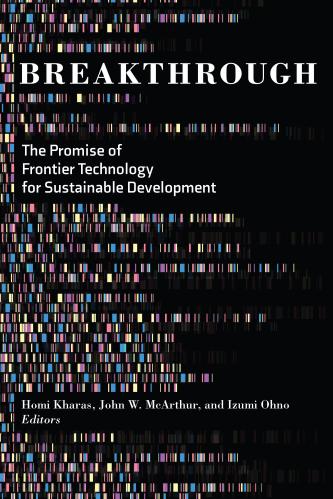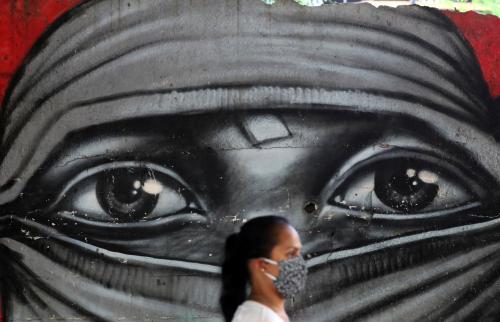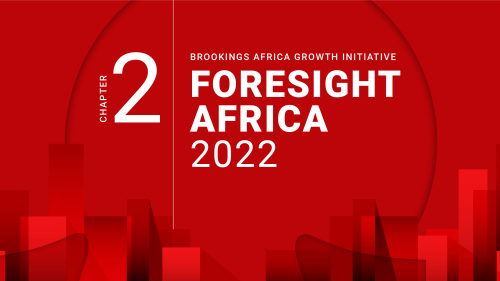It has been two years since COVID-19 took the world by storm, altering life as we know it. Prior to its emergence, the Global Health Security Index noted that no country was fully prepared to tackle a pandemic. This unpreparedness, however, was not due to a lack of scientific or technological progress. Rather, it was a result of our collective failure to adapt each nation’s economic and policy systems to reap the full benefits of these tools, a step that the editors of “Breakthrough,” Homi Kharas, John McArthur, and Izumi Ohno, suggest is critical for success. In our book chapter, we describe not only the technologies but also the policy and economic needs that must be met to achieve what we define as success—baseline pandemic preparedness in every nation—by 2030.
Two major technological breakthroughs have powered our global response to COVID-19. First, advances in biomedical and genomic technologies have allowed us to detect and characterize viruses like SARS-CoV-2, and develop countermeasures like vaccines and therapies with unprecedented speed. Second, powerful new information technologies and systems have allowed us to collect data in real-time, conduct viral surveillance, and coordinate local, national, and regional health systems. While scientists are constantly working to optimize and expand this arsenal, the technologies we have today show great promise for the future of global health.
But the technology alone is not enough. In our chapter, we note three foundational elements necessary for the successful implementation and scale-up of each technological breakthrough. They include regular coordination and collaboration between scientists, public health, and global leaders; equity and community empowerment; and sustainable financing. In the context of COVID-19, many nations have failed to lay this groundwork, leading to a response marked by inequity and frustration.
Despite several improvements in the technology, diagnostic testing remains a challenge, as supply hoarding, prioritization of some communities over others, and failure to build local capacity exacerbate access issues everywhere. For example, individuals in several high-income nations are now able to purchase antigen tests that provide results at home in 15-30 minutes. At the same time, socioeconomically disadvantaged populations and/or communities of color in many of those wealthy nations like the U.S. continue to face obstacles in accessing tests, including cost, long test lines, remoteness to testing centers, and other systemic inequities that policymakers have yet to address. In low- and middle-income nations (LMICs), testing barriers are more broadly prevalent, ranging from high costs for tests (both direct and indirect) to limited testing capacity in community sites.
The global distribution of countermeasures like vaccines and therapies is also fraught with inequity. In the U.S., like many high-income nations, fully vaccinated individuals now comprise 64 percent of the population, as of early February 2022. By comparison, just 10.6 percent of individuals in low-income nations have received at least the first dose, partially due to vaccine hoarding by their high-income counterparts. Socioeconomic and racial disparities around access to vaccines in wealthier countries have mirrored the same dynamics present with testing, especially in the earlier phases of vaccine rollout. In the U.S., some of these disparities have reduced over time, but various barriers remain, including English language proficiency, technology and information access, as well as vaccine hesitancy and mistrust. A worldwide scan of access to monoclonal antibodies, proven effective in treating diseases including COVID-19, reveals similar challenges, with the U.S., Canada, and Europe owning 80 percent of the existing global supply.
Our chapter also describes recent advances in information technology that have facilitated the gathering, sharing, and analysis of COVID-19 data. Yet a lack of coordination, as well as gaps in capacity and existing infrastructure, have marked the data side of the pandemic response as well. Even two years later, data collection is often done by paper, email, or electronic medical systems, particularly in low-resource settings. In Sierra Leone, Dr. Isatta Wurie and Dr. Nellie Bell of the College of Medicine and Allied Health Sciences note various “bottlenecks in data integrity” that prevent “timely policy change during the pandemic,” including paper-based data collection, missing data and entry errors, system downtime, lack of resources, and limited personnel capacity. In the U.S., a number of laboratories use fax, mail, or even email to report data, while health departments depend on disparate, manual data tracking systems.
A major theme of this book is that technology should reduce inequality and empower people. But too often, it achieves the exact opposite, expanding the divide between those with resources and those without. Kharas, McArthur, and Ohno note that the pandemic shed further light on this reality, worsening inequalities both within and between countries, as wealthy nations rolled out vaccines and other mitigation tools with record speed, leaving many LMICs behind. In the context of infectious disease, competition for resources is not only unethical but also counterproductive, since a virus anywhere is a threat to global health everywhere. It is therefore critical that we create a new culture of global cooperation and collective responsibility around responding to infectious disease. To overcome COVID-19 and prepare for the next pandemic, global leaders must understand the following:
Equity is intertwined with empowerment
As we work to increase the global vaccine supply, detection tools and therapies must be more equitably distributed. In the immediate term, high-income countries and global organizations should work to increase community testing capacity in low-resource settings by providing more affordable rapid diagnostic tests and implementing “pop-up” community testing centers in areas of high need. In the long-term, the global community must also empower local scientists, by expanding PCR and genomic surveillance capacity in laboratories worldwide through technical, financial, and logistical support.
To tackle vaccine equity, the global community requires structures and standards to discourage vaccine hoarding, increase vaccine supply, and rapidly distribute vaccines to those with the highest need. In addition to loosening patent protections, high-income nations and multilateral institutions must also empower local manufacturers in underserved regions, through technology transfer, material assistance, and local capacity building. On the delivery side, organizations like COVAX have made important progress, but many have criticized their vaccine targets as not ambitious enough. While the global community works to meet higher targets, support of last mile efforts to distribute and deliver vaccines will remain critical. Leaders everywhere must also strive to build newfound public trust in science, health care, and the government through community education and clear, transparent communication about the value and safety of vaccines.
Sustainable financing means increased investment in both the short- and long-term
In addition to the efforts undertaken by coalitions like the Access to COVID-19 Tools Accelerator (ACT), rapidly scaled-up domestic and international investments will be critical to building global pandemic preparedness. According to the G-20 High Level Independent Panel convened in early 2021, LMICs will need to add around 1 percent of their GDP to domestic public health spending over five years, while cross-border financing will have to rise by at least $15 billion per year. On a systems level, the panel also recommended a global governance system for equitable distribution of tools and coordination of goals, involving a Global Health Threats Board, Council, and Fund, guided by the World Health Organization at the center.
Public health infrastructure across the globe must be modernized and systems rebuilt for maximum efficiency
Real-time communication and coordination, as well as open data sharing, allow public health, scientists, and leaders to better understand and respond to the needs in communities. To make this a reality, we need global digitalization of data collection, regional standardization of data infrastructure, as well as an interoperable ecosystem where information can be easily accessed. Regional efforts for digitalization by organizations like the Africa Centres for Disease Control and Prevention (CDC) are currently underway, according to Drs. Wurie and Bell, but these efforts can be further supported through global partnerships for capacity building, integration into the local context, and sharing of best practices.
Ultimately, preparing for the next viral threat will require the creation of new infrastructure, sustainable financing, and a global spirit of collaboration marked by equity and empowerment. As we enter the third year of the pandemic, we are all faced with an important question. The technology is already evolving to meet the many challenges of a pandemic-susceptible world—are we as a global community willing to evolve along with it?







Commentary
Harnessing technology for pandemic preparedness demands system reform
February 18, 2022